The World
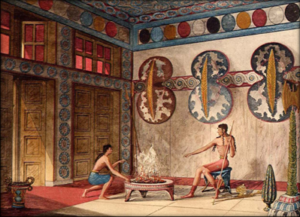 The regions of the world are best understood by the people who live there.
The regions of the world are best understood by the people who live there.
Humans, who call themselves the True People, live in the middle realms around the Middle Seas and ply the waters in a grand international commerce. Himhet, Asnam, and Sebilos demihumans dwell in the wilderness along the edge of the Great Ice in the north. Along the arid shores of the south, humans and humanoids struggle for survival in the deserts.
Understanding the various regions of Haya is best achieved by reference to the peoples who live there and the geographic and natural challenges they face.
True People (Humans). The various human peoples of Haya call themselves collectively the True People, as opposed to the Outer People demihumans, most of whom are analogous to archaic humans in the real world, and Under People humanoids, among whom are archaic humans and highly evolved ape-like creatures. There is a philosophical question about who truly constitute the True People, but the general understanding is that only certain dark-haired, dark-skinned, dark-eyed people who live along the coasts qualify for the term. Most of the True People have some nations in the Bronze Age, but the Zitan and Entihoma remain entirely in the Stone Age.
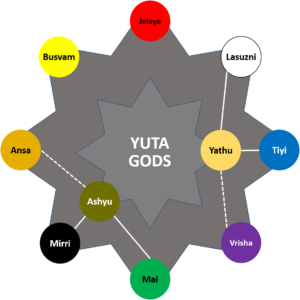 Yuta (The Tower People) These are the most widespread humans, living primarily in seaside clandoms and city-states throughout the middle of the world of Haya. Their leaders, called yútan (feminine yutáni) in the Yuta stone language, build stone tower fortresses (yútan-dámbi) surrounded by stone houses, in hill fort towns and more advanced cities that grew up around such fortresses. The basis of their diet is wheat bread and fish, although beef, olives, and grapes are also important.
Yuta (The Tower People) These are the most widespread humans, living primarily in seaside clandoms and city-states throughout the middle of the world of Haya. Their leaders, called yútan (feminine yutáni) in the Yuta stone language, build stone tower fortresses (yútan-dámbi) surrounded by stone houses, in hill fort towns and more advanced cities that grew up around such fortresses. The basis of their diet is wheat bread and fish, although beef, olives, and grapes are also important.
The Yuta share a cult headed by a fertility goddess named Ashyu represented by long whales and a sky god named Yuthu represented by the sun. She is the deity of water and dark and earth, while He is the deity of lightning and air and light. The rest of the pantheon includes the smith god Busvam governing metal, the hearth goddess Jelaye, governing fire, as well as demigods of the other elements, the children of Ashyu and Yuthu: Ansa of stone who rides the celestial bull Sitara, Mirri the serpent of dark, Mai of the seas, Vrisha of storms, Tiyi of the sky, and Lasuzni of light.
The Priests of Ashyu and Yuthu enjoy courtly status among most Yuta peoples, while the Priesthoods of the other gods are usually only popular cults.
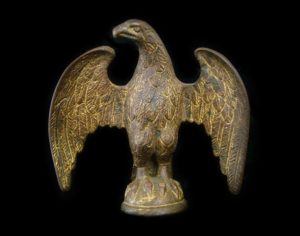 Tadoman Empire (The Bronze Crown). The Tadomans are the central Yuta people, who control a Bronze Age empire centered in the city of Tadoma on the Vindha Peninsula, the central valley of which is known as Etudwa and is divided by two rivers: the Hamhes to the east reaching north into Hallia and the shorter Wuyira to the west.
Tadoman Empire (The Bronze Crown). The Tadomans are the central Yuta people, who control a Bronze Age empire centered in the city of Tadoma on the Vindha Peninsula, the central valley of which is known as Etudwa and is divided by two rivers: the Hamhes to the east reaching north into Hallia and the shorter Wuyira to the west.
The emblems of the Empire of Tadoma include two blue stripes in a field of white (said to symbolize the twin rivers) and the royal eagle, symbol of elemental lightning. In the Empire, only members of the royal clan are permitted to wear purple, and the eagle-thunder demigod Vrisha is considered the ancestor of the native Tadomans.
After centuries of wars among Etudwan city-states, Tadoma subdued the other Etudwa clans and cities three generations ago, and continue to make excursions into the high Hamhes valley of Hallia to the north and the island of Divesh to the south. The Kings (Etun) of Tadoma wear the Bronze Crown, a century-old artifact they won from the vanquished city of Taeya, a relic which is said to grant its wearer magical powers. The current Etun of Tadoma, Izkanobil, in his zeal for the god Yathu banished the Priestesses of Ashyu, who fled to the neighboring Tydhem and Tudvam city-states. Relations with the Tydhem and Tudvam are further complicated by the sea Rogues of those peoples, who plague shipping from Etudwa.
The Tadomans, and Etudwans in general, are known as very practical people. Their working of bronze is considered supreme, and they harness the power of the Twin Rivers to irrigate fields, drive mills, and channel trade via canals bypassing the several cataracts of Vindha. Their Warriors include organized soldiers, champions who fight in single combat before battles, and free fighters. Scribes are highly revered, as are Trackers who serve as guides for incursions into Hallia. Priests of Yuthu enjoy high status, with Priest of Ashyu officially banned, and the Priests of other gods living in uncertainty about their status.
The valleys of Vindha are temperate and subtropical forests, dotted by farms growing wheat, olives, and grapes. Elephants, lions, and monkeys live in the countryside, as well as ancient retreats for Priestly devotees of the lesser gods. Despite Izkanobil’s reforms, the people maintain a covert and illegal dedication to the goddess Ashyu.
The winds of Etudwa vary between the weak inland breezes of winter and the strong and cool Eutua wind of the months of Gai through Aurtum, which rages down the valleys from Hallia to drive ships from the ports of Tadoma and Taeya. This pattern means that Traders tend to leave the Tadoman Empire in the summer and return in winter. It also means that the climate of Etudwa is quite mild, with the rains coming during the breezes of winter and the cool Eutua wind keeping summer from being too hot.
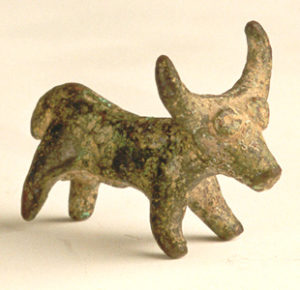 Tydhemia. The Bronze Age people around the Sea of Tydhemia are closely related to the Tadomians. They live in city-states driven by sea commerce, sending ships full of Traders throughout the world. The Tydhem control both East Tydhemia on the eastern shores of the Vindha Peninsula, West Tydhemia on the eastern shores of the Zasai Peninsula, and the islands of Ktoakia, Nodmia, Alnano, Aftaia, Thaela, and Shased.
Tydhemia. The Bronze Age people around the Sea of Tydhemia are closely related to the Tadomians. They live in city-states driven by sea commerce, sending ships full of Traders throughout the world. The Tydhem control both East Tydhemia on the eastern shores of the Vindha Peninsula, West Tydhemia on the eastern shores of the Zasai Peninsula, and the islands of Ktoakia, Nodmia, Alnano, Aftaia, Thaela, and Shased.
Their lands are rocky, with forested uplands where reclusive Razu quasihumans haunt remote wooded gorges. The rural coast between East Tydhemia and Addaz are plagued by vicious, copper-skinned Zhydh humanoids.
The cultural emblems of the Tydhem include green-and-black stripes and the bull. Among the Tydhem, wearing the color green is confined to those who have been to sea. The yútan (called tyrhan) of Tydhem are all sent to sea as boys on tours of the Middle Seas.
The stone demigod Ansa, who rides the celestial bull Sitara, is considered the ancestor of the Tydhem. The Priestesses of Ashyu are quite powerful among the Tydhem, and the cults of Yathu, Busvam, and Jelaye are considered subordinate. The Tydhem are known for their seafaring Traders and Rogues, who roam the waters from Inet to Zemed to Zasai and Yasayoi. As among the Tadomans, their Warriors include organized soldiers, champions who fight one-on-one before battles, and free fighters. Scribes are highly revered, maintaining ties most closely with the Diveshi and Damdilit.
In winter, the winds of the Sea of Tydhem are chaotic, but in summer a strong, cool wind called the Dande pours out of the north-northwest to help drive ships out of Tydhem. This means that Traders sail out of the Tydhem Sea during summer and return in winter. It also helps keep the climate of Tydhem remain mild throughout the year.
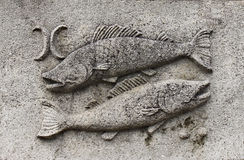 Tudvam and the Islands. To the west of the Tadoman Empire are the closely related Bronze Age Tudvam people, who live in city-states along the west coast of Vindha and in clandoms on the islands of Idsam, Amastina, Malki, Iskani, Votti, and Shattem.
Tudvam and the Islands. To the west of the Tadoman Empire are the closely related Bronze Age Tudvam people, who live in city-states along the west coast of Vindha and in clandoms on the islands of Idsam, Amastina, Malki, Iskani, Votti, and Shattem.
The cultural emblems of the Tudvam include brown-and-purple stripes and the fish. The sea demigoddess Mai is considered the ancestor of the Tudvam. The cults of Ashyu and Yutha are joined among the Tudvam, their Priests and Priestesses being married couples, and the Priesthoods of the lesser gods enjoy close ties to them.
As among the Tydhem, seafaring Traders and Rogues are common among the Tudvam, ranging from Atzot to Zemed to Zasai and Yasayoi. Tudvam towers are known as nyuram, their rulers as nyuri. The settlements built up around nyuram incorporate fresh and/or salt water terraces where they keep fish both for food and ornamentally.
The lands of the Tudvam are rocky, with heavily forested uplands were Razu quasihumans live. The rugged coast between mainland Tudvam and Sihut is haunted by fierce, copper-skinned Zydh humanoids.
During winter, the Dheteva wind presses from the southwest during the months of Hruntuz and Aftam, while the summer Govai wind from the northwest blows from the month of Gai through Kupria. This greatly benefits the Traders of Tudvam, but tends to make it easier to trade eastward than westward. Rich kelp forests line the shores of the Tudvam.
Sihut. The Stone Age farmers of Sihut, who make use of bronze tools traded with the Tudvam, live along a coastal frontier with the cave-dwelling hunter-gatherers of the Zitan people. Sihut have close political and trading ties with the Tudvam, from whom they were colonists centuries ago. During this colonization, the Zitan were brutally driven from the coast, but a rapprochement has followed in which trading ties were established and the rights of the Zitan to visit cavern shrines in Sihut were secured.
The cultural emblems of the Sihut are the same as the Tudvam, brown-and-purple stripes and the fish. The demigoddess of dark, Mirri the Serpent, is considered the ancestor of the Sihut, and shadowy cults to this feared deity thrive in the Sihut city-states.
Trackers are common among the Sihut, as are Traders with the cave-dwelling Zitan for goods they bring from their their forested lands, mostly furs and ivory.
During the winter, the onshore breeze drive ships into Sihut, but the strong Govai wind from the north blows ships out during the summer. This drives trade, but also keeps the climate mild. The woods and fields of Sihut are marked by rocky outcroppings which often make farming difficult. For this reason, Sihut focus on trading and herding sheep and goats. The rugged lands of the Sihut are filled with scrubs and bushes, including the deadly hemlock.
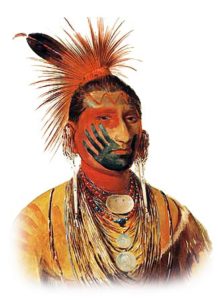 Inet. The land of Inet and its neighboring lands—Hintashya, Qitam, Hyz and Naseati, and the Hiam Islands—are home to Stone Age farmers who live in chiefdoms under many competing yútan. They have straight black hair, dark eyes, and tan skin. They are a colorful people, with a vibrant trade for dyes. They were early migrants of Yuta expansion, and once also inhabited the islands where the Tudvam now live. They retain a language very close to the Yuta stone language.
Inet. The land of Inet and its neighboring lands—Hintashya, Qitam, Hyz and Naseati, and the Hiam Islands—are home to Stone Age farmers who live in chiefdoms under many competing yútan. They have straight black hair, dark eyes, and tan skin. They are a colorful people, with a vibrant trade for dyes. They were early migrants of Yuta expansion, and once also inhabited the islands where the Tudvam now live. They retain a language very close to the Yuta stone language.
The Inet of Haya are somewhat similar to North American tribes, growing corn, squash, and beans (which they discovered in Inet) using fish as fertilizer, and fighting with clubs, hand axes, and bows. Their cultural emblems are feathers and red-and-black body dyes. They can be Trackers, Shaman, and Poets (illiterate).
Among the Inet peoples, the four main Yuta gods share equal status, but they consider themselves the children of Jelaye. Among the Inet, Poets (bards) are highly revered, and they are renowned for their mastery of diverse musical instruments, including bone flutes, wooden drums, and bow-like stringed instruments.
Long ago, there was a highly civilized and centralized Stone Age nation on the island of Inet, known as the Sky Chiefs. They left earthenwork pyramids and megalithic structures throughout the islands, largely in areas now retaken by the wilderness. Now they live in tribal confederacies, mostly along the coasts.
The Inetili are fierce fighters who often raid the Badwam, Awriye, and Tibye for tribute and slaves. The Hafed hold off the Inetili with help from Zakhten. The confederacies of Hiam, Hintashya, and Hyz and Naseata maintain their independence by maintaining better sea canoes than the Inetili. Qitam try their best to assist the Awriye and Tibye, but they are also subject to occasional raids over the mountain passes from Vyozah.
The lands of the Inet are generally rugged with heavily wooded uplands, with holly being prevalent among the evergreens of the high hills. However, Hintashya is a low island fringed with swamps. On the island of Inet, Razu quasihumans live in a network of strong clanholds in the forested high country, much of which was reclaimed after the Sky Chiefs fell. The coastal Inet maintain trade with them—notably for mirrum ore, which is more plentiful in the mountains of Inet than elsewhere.
The climate of Inet is typified in the months of Aftam and Feret by thunderstorms and rains (or snows in the north of Inet) while the summers are hot with still winds, while autumn and early winter are quite dry.
Atzot. The Stone Age farmers living along the coasts and offshore islands of the far west are renowned as seafarers, their traders reaching from Qiley to Tydhemia. Their own lands supply few trade goods, so they rely heavily on the trade of tin/sitanum from the north. The Atzot people sail hide-hulled boats revered for their seaworthiness. Being illiterate, they have no Traders, only Warriors, Trackers, Poets, and Shaman.
They share close cultural ties with the Inet, whose language is very close to theirs. The Atzot appear much as the Inet—straight black hair, dark eyes, and tan skin—but they dress in very plain black and blue colors with no feather adornments.
In Atzot, Ashyu is revered as a goddess represented by giant sharks, the other Yuta gods enjoying subordinate devotion. The Atzot consider themselves children of the sky demigod Tiyi. The cultural emblems of the Atzot are black-and-blue checkers and the shark. They have a bellicose relationships with the Zitan people of Vyozah, and their mainland towns maintain a martial vigilance, the island towns being more open and mercantile.
The wet season of Atzot stretches from the month of Hruntuz to early Argenia, when the clearing of clouds marks the rise of light, thunderstorms most common (of course) in Feret. The rest of the year is clear and generally windless, making trade difficult. The shores and islands of Atzot are marked by tallwood forests between the farms.
Qiley and Zam. The remote Stone Age farmers of these islands are known for their mines of tin/sitanum, which they trade through the Atzot and Inet peoples. The Yuta gods are revered alongside the Spirit Folk, who are particularly strong on these islands. Like the Atzot, they consider themselves descended from Tiyi, and remember that they colonized their lands from Atzot centuries ago.
The people of Qiley and Zam appear much as the Inet—straight black hair, dark eyes, and tan skin—but they dress in very plain green-dyed clothes. Some of them have interbred with the Himhet, and have paler skin and red hair.
The yútan of these islands are of the Shaman class, but are gentle leaders. Their people can be Trackers, Poets, and Shaman. The cultural emblems of Qiley and Zam are white-and-green checkers and the giant Qileyan deer. They trade with the Atzot and the nearby Himhet for furs and mammoth ivory.
The wet season of Qiley and Zam stretches from the month of Sitamber to Gai, thunderstorms most common (of course) in Feret. The rest of the year is clear and generally windless, making trade difficult. These lands are filled with tallwood trees, between which are the hills and cleared fields of the farmers.
Divesh and Masya. The Bronze Age, seafaring folk of these islands act as traders from Inet to the islands of the Adya. They live in city-states governed by stern aristocrats. The Priesthoods of Ashyu and Yathu are combined in a royal cult, the yútan royal couple being the High Priest and High Priestess of Ashyu and Yathu, with the Priesthoods of the lesser gods relegated to folk cults in the countryside. Nevertheless, the Divesh and Masya people consider themselves descended from Busvam.
The people of Divesh and Masya have dark curly hair, dark eyes, and dark tan skin. The cultural emblems of these people are a pale green diamond in a field of dark purple, and a black whale. The main city of Divesh, Ithios, is home to the greatest library of chronicle stones in the civilized world, and regularly hosts conventions of all the Scribe societies.
Divesh is plagued by bull-men (minotaurs) and snake-men (nagas), as well as fierce Zydh humanoids dwelling in the uplands, and poisonous giant snakes. The Diveshi lion is large and known for its brightly golden fur.
The summer wind Eutua gets dissipated over the Sea of Divesh, but occasionally persists during the late Argenia and early Kupria along the east coast of Divesh to drive ships south. Likewise, the winter wind Dheteva from Zemed occasionally persists during late Hruntuz and early Aftam along the west coast of Divesh to drive ships north. For the rest of the year, the daily cycle of onshore and offshore breezes drive the climate. It can be quite hot during summer, and mild during the winter.
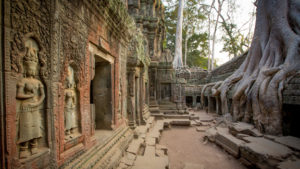 Wesadhi. These islands were conquered centuries ago by Yuta people from the ancient Sea Empire of Qesadh in the lands now inhabited by the Tydhem, from which lands the Wesadhi ancestors were driven.
Wesadhi. These islands were conquered centuries ago by Yuta people from the ancient Sea Empire of Qesadh in the lands now inhabited by the Tydhem, from which lands the Wesadhi ancestors were driven.
In Wesadhi, there remains an indigenous Stone Age Adya people called Kaba in the uplands, as well as Tsote quasihumans and Metamhi humanoids.
During the conquest, Wesadhi yútan accommodated the Adya religion, identifying Ashyu with the Adya sea goddess Hutiya and Yutha with the bird god Hatu. Their sponsorship of the local religious class has resulted in a strong Priestly class aligned with the ruling yútans. The Wesadhi consider themselve descended from the light demigoddess Lasuzni.
Wesadhi emblems include braided, brightly colored threads of all the elemental colors, an iconic white eye, and the white flower of the magnolia tree. The Wesadhi islands are typified by tropical forests inhabited by red-and-black striped tigers, elephants, shovel-tuskers, and monkeys. Spirit folk, tiger-men (rakshasas), and golems haunt the countryside.
The strong Janis wind from the south pummels Wesadhi with rainstorms from the month of Aftam through Gai. For the rest of the year, onshore and offshore winds dominate the climate. The month of Kupria is excessively hot and dry.
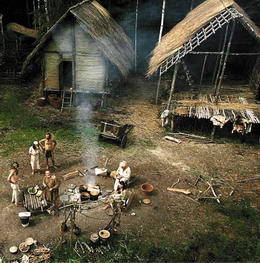 Hallia. The high valley of the Hamhes above Vindha is home to the Stone Age Halli farmers. They are a fierce people, with spear-throwers and hand-held spears. Among the Halli, Ashyu is goddess of the rain and Yathu god of the storm, with Her children Mai and Mirri in charge of water and dark and His children Tiyi and Lasuzni in charge of the sky and light. Busvam is considered the consort to Ashyu and Jelaye the consort to Yathu. The stone god Ansa and lightning god Vrisha are minor deities.
Hallia. The high valley of the Hamhes above Vindha is home to the Stone Age Halli farmers. They are a fierce people, with spear-throwers and hand-held spears. Among the Halli, Ashyu is goddess of the rain and Yathu god of the storm, with Her children Mai and Mirri in charge of water and dark and His children Tiyi and Lasuzni in charge of the sky and light. Busvam is considered the consort to Ashyu and Jelaye the consort to Yathu. The stone god Ansa and lightning god Vrisha are minor deities.
Hallia is a temperate grassland inhabited by shovel-tuskers, cave bears, cave lions, and wild horses. White Peyu humanoids live in the glaciered mountains. Hallia is separated from Etudwa by a steep gorge known as the Gate of Hamhes, which stand as a formidable barrier against incursions by the Tadoman Empire. There are also several mountain passes leading to Nyupam. The Halli people grow wheat and keep sheep and goats.
The Halli have resisted Tadomian invasions for a century, countering the Bronze Age weapons of the south with sheer warrior discipline. The emblems of Hallia are green-and-purple stripes and the cave lion, which they consider their ancestor. Unlike the other Yuta people, they are illiterate, and may only be Warriors, Trackers, and Shaman.
During winter, the air in Hallia is calm and cold. Rains and snows generally fall in Aftam, Feret, Aurtum, and Sitamber. During the summer, the cold wind of Eutua from the mountains of Halbhar keep the summers cool, keeping the climate quite cool.
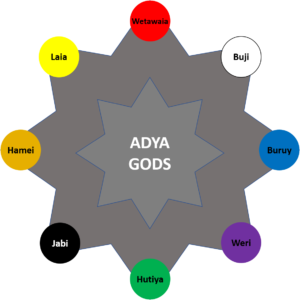 Adya (The Boat People) These humans have straight black hair, brown eyes, and light tan skin. They live in the far east of Haya, primarily in coastal city-states and towns. Despite that seafaring is also known among the Yuta and Agtile, it is so essential to the Adya way of life that they are known as the Boat People.
Adya (The Boat People) These humans have straight black hair, brown eyes, and light tan skin. They live in the far east of Haya, primarily in coastal city-states and towns. Despite that seafaring is also known among the Yuta and Agtile, it is so essential to the Adya way of life that they are known as the Boat People.
The Adya spread from Yaira about the same time the Yuta spread from their unknown homeland. They spread first to Mijam and Zasai, and from Zasai throughout the rest of the islands now controlled by the Adya, and Wesadhi, which was conquered more recently by Yuta from what is now Tydhem. The Adya from archaic Zasai encountered the short Tsote quasihumans in Wesadhi (who are related to the Razu who dwell in Yuta landss) and drove them into the uplands.
The Adya share an elemental cult headed by the sea goddess Hutiya (water), the hearth goddess Wetawia (fire), the elephant god Hamei (earth), and the bird god Buruy (air). Lesser cults exist, honoring the night god Jabi (dark), the day god Buji (light), the war/wealth goddess Laia (metal), and the storm goddess Weri (lightning).
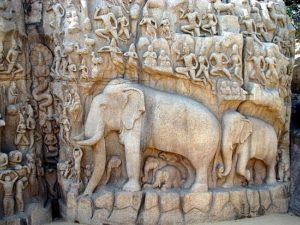 Zasai (Banua Binanga League). The lower valleys of the Zengulay River, both the east and west branches, are home to one of two nexi of Adya civilization, the other being Mijam. The Bronze Age cities of Zasai have joined in a league, called the Banua Binanga, under the leadership of the central city of Kaivai. These cities grew up from trade in rice and jade, their waha rulers sending boats from Mijam to the Far Islands to Tadoma on trading missions.
Zasai (Banua Binanga League). The lower valleys of the Zengulay River, both the east and west branches, are home to one of two nexi of Adya civilization, the other being Mijam. The Bronze Age cities of Zasai have joined in a league, called the Banua Binanga, under the leadership of the central city of Kaivai. These cities grew up from trade in rice and jade, their waha rulers sending boats from Mijam to the Far Islands to Tadoma on trading missions.
The Zasai honor the elephant god of earth, Hamei, higher than all others. Their core color is orange, which each city blends with a square border of another color: Kaivai with black, Lamai with white, and Anjira with purple.
Zasai Trackers range into the high Zengulay valley for precious gems and metals, facing the threat of the Red Peyu humanoids. The fishing and trading guilds of Zasai are filled with Rogues and Warriors, and have a standing commission as supplements for the royal navy in times of war. They also have Traders, Priests, and Scribes.
The strong Janis wind from the south pummels Zasai with rainstorms from the month of Aftam through Gai. For the rest of the year, onshore and offshore winds dominate the climate. The month of Kupria is excessively hot and dry.
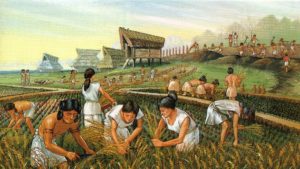 Mijam and the Islands. The civilization of Mijam—with its tributaries on Ilomapa, Yaira, Jai, and Huaz—is one of two nexi of Adya civilization, along with Zasai. The emperor of Mijam, the High Waha Ksajomara, rules over a hierarchy of lesser waha who administer their tributary banua with the close guidance of the Priests of the hearth/fox goddess Wetawia.
Mijam and the Islands. The civilization of Mijam—with its tributaries on Ilomapa, Yaira, Jai, and Huaz—is one of two nexi of Adya civilization, along with Zasai. The emperor of Mijam, the High Waha Ksajomara, rules over a hierarchy of lesser waha who administer their tributary banua with the close guidance of the Priests of the hearth/fox goddess Wetawia.
The Warriors of Mijam are renowned for their skill with a short sword called the jiyi. Their Trackers are seafarers who land on the forested shores of the Otovyi and the steppes of the Sebilos. The trade in rare fruits, ivory, and gaitite the Trackers secure help drive the Mijam economy. Their own lands, forested islands with resource-rich coastlines, produce rice, seafood, and beef. These islands are haunted by Spirit Folk, monkeys, intelligent octopuses, and magical deer known as jali who are aligned with snow as a quasi-element strongly opposed to fire.
Mijam can also be Traders, Rogues, and Scribes. The Mijam fly banners of red, yellow, and white. The tributary states are permitted to fly derivative colors: Ilomapa flies red and white, Yaira red and yellow, Jai yellow and white, and Huaz black, red, and white.
The Dimobu wind of the months of Hruntuz and Aftam bring snows to these islands, but the rest of the year is dominated by onshore and offshore breezes. The climate during these times is quite mild.
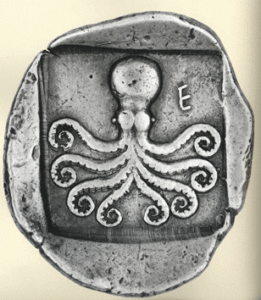
A yasandai coin.
Yasayoi. The Stone Age farmers and fishermen of these islands are renowned for their boatmanship. They can be Trackers, Rogues (the elite only), Poets, and Shaman.
The waha of the Yasayoi are Rogue chiefs living in large, quasi-urban villages. They encourage all sorts of incursions into neighboring Zasai and Wesadhi territories, including shore fishing and hunting, theft and raids against local villages, and open seas piracy. At the same time, they maintain covert allegiances with local Zasai and Wesadhi leaders, offering “protection” from incursions as well as trade gifts (including slaves) in exchange for passage unharrassed by local patrols and specially minted tin coins called yasandai.
The Yasayoi believe their divine ancestor is the water goddess Hutiya, whom they consider to be an octopus, and range surprisingly wide considering the moderate size of their canoes, which they lash together with cross-poles by twos, threes, and fours to increase their seaworthiness. While they focus their Rogue-ish behavior on their neighbors, they trade (via sea Trackers) from Mijam to Inet and Aysay, most famously in spices from their own lands, and from eastern Wesadhi and the Far Islands.
The Yasayoi islands are forested mountains where Metamhi dwell, lowlands farmed for rice and coconuts, and marshy coastlines haunted by crocodiles and huge constrictors. The strong Janis wind from the south pummels Yasayoi with rainstorms from the month of Aftam through Gai. For the rest of the year, onshore and offshore winds dominate the climate. The month of Kupria is excessively hot and dry.
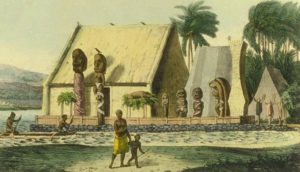 The Far Islands. The illiterate, Stone Age outer islands of the Adya are: Imfoi and Little Imfoi on the edge of Wesadhi; Vasefomoi; the Zivtoi archipelago; the Wasau archipelago; and the archipelago of Zesam along the edge of Vava. All but Zesam were settled centuries ago from the Imfois, which were settled from Yasayoi. The peoples of the Far Islands are Stone Age farmers and fishermen who largely communicate with the rest of the world through the Yasayoi.
The Far Islands. The illiterate, Stone Age outer islands of the Adya are: Imfoi and Little Imfoi on the edge of Wesadhi; Vasefomoi; the Zivtoi archipelago; the Wasau archipelago; and the archipelago of Zesam along the edge of Vava. All but Zesam were settled centuries ago from the Imfois, which were settled from Yasayoi. The peoples of the Far Islands are Stone Age farmers and fishermen who largely communicate with the rest of the world through the Yasayoi.
Each of the Far Islands have a waha who relies heavily on Shaman aligned with the bird god Buruy to guide their tribes. They can be Trackers, Shaman, and Poets. Among the people of the Far Islands, Poets are the most well-organized class, called Itoia, maintaining inter-island contacts to share songs, both magical and otherwise.
These peoples consider themselves descended from birds, and see their sailing canoes as attempts to recapture the joy of flight. The Travelling Wind out of the east dominate the climate of the Far Islands, occasionally and randomly interrupted by lulls that last for a several weeks at a time.
Kaba. The Stone Age people of the uplands of Wesadhi live in nomadic tribes among the Tsote and Mesamhi. They maintain some ties with the Wesadhi people along the coast, but hostilities often arise. They can be Trackers and Shaman. Kaba who have lived among the Wesadhi can also pick the Rogue class.
The Kaba consider themselves descendants of the octopus Hutiya, as the Yasayoi, but since they have been separated from the sea they have dedicated themselves to the night god Jabi.
The Kaba shave their heads in geometric patterns and paint the bare patches in bright colors. They maintain close ties with the Tsote quasihumans and Metamhi humanoids.
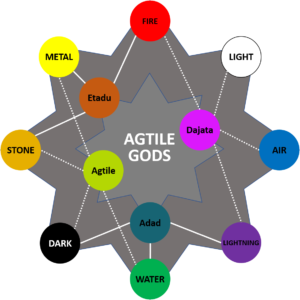 Agtile (The South People) These humans have curly black hair, brown eyes, and dark skin. They live along the coasts of the south-west of Haya. The Agtile Kingdom of Zemed is revered as representing the most ancient civilization.
Agtile (The South People) These humans have curly black hair, brown eyes, and dark skin. They live along the coasts of the south-west of Haya. The Agtile Kingdom of Zemed is revered as representing the most ancient civilization.
The Agtile follow a cult headed by the fertility/sea/rain goddess Agtil—representing water, earth, dark, and metal and represented by the giant crocodile—and the thunder/sun god Dajata—representing lightning, air, light, and fire and represented by the hawk. Agtil and Dajta have two children: Etadu, the god of war, and Adad, the goddess of storms.
The Agtile are ruled by qatua, who head both the royal and Priestly classes. Qatua have differing forms of power in the three Agtile people. Their children, inqatua, often hold positions of high responsibility.
 Zemed. The Bronze Age kingdom of Zemed is an ancient and conservative culture, remaining largely unchanged for centuries. The Scribes of Zemed have been keeping records nearly as long as the Yuta. Before that, they kept chronicles orally, and transferred many of these oral accounts to chronicle stones. The Zemed are much like the ancient Egyptians and Mesopotamians, building monumental architecture to their gods and rulers, and keeping copious records of genealogy and history.
Zemed. The Bronze Age kingdom of Zemed is an ancient and conservative culture, remaining largely unchanged for centuries. The Scribes of Zemed have been keeping records nearly as long as the Yuta. Before that, they kept chronicles orally, and transferred many of these oral accounts to chronicle stones. The Zemed are much like the ancient Egyptians and Mesopotamians, building monumental architecture to their gods and rulers, and keeping copious records of genealogy and history.
Zemed lies along the lush valley of the River Kayat, surrounded by desert, and the cities of Zemed are built to take the most advantage of the waters of the river. Zemed farmers grow wheat and barley, and draw fish from the river. The waters of Kayat are plagued by giant crocodiles and hippopotami. Temples to all four gods line the river, and the Priests hold high status.
The Zemed qatua consider themselves descendants of of the demigod Etadu, who is represented by the desert lion which has a yellow coat and a reddish mane. These colors, red and yellow, appear in the banner of the Kingdom. The current qatua of Zemed, Tazdad IX, is very old and has only one child, the inqatua (prince/princess) Migitye is a strong woman in her 30s who handles the daily affairs of the kingdom.
Zemed sends sea Traders from Inet to Tadoma to Wesadhi. They also take advantage of desert Izakhez to trade with Zakhten and Aysay across the desert, and have incorporated civilized Ezolite giants into their armies. The Zemed can be Warriors, Trackers, Rogues, Poets, Scribes, Traders, and Priests.
 Zakhten and Aysay (Tankixa). The Stone Age city-states in the lands of Zakhten and Aysay are ruled by qatua who align themselves equally to the Priesthoods of Agtil and Dajata, with a strong royal cult to Adad. Etadu is represented by the giant jaguar. They are collectively known as the Tankixa (pronounced tankisha), but this term is rarely used due to the strong rivalry between the two peoples. They are much like Pre-Columbian civilizations, building grand temples and trading in maize, peppers, and the yellowish wool of a llama-like camel called isqavu.
Zakhten and Aysay (Tankixa). The Stone Age city-states in the lands of Zakhten and Aysay are ruled by qatua who align themselves equally to the Priesthoods of Agtil and Dajata, with a strong royal cult to Adad. Etadu is represented by the giant jaguar. They are collectively known as the Tankixa (pronounced tankisha), but this term is rarely used due to the strong rivalry between the two peoples. They are much like Pre-Columbian civilizations, building grand temples and trading in maize, peppers, and the yellowish wool of a llama-like camel called isqavu.
These people can be Warriors, Trackers, Rogues, Poets, Scribes, and Priests. They consider themselves descended from the shark goddess Adad, who demands blood sacrifice to manage the seasonal cycle of storms. The lands of the Zakhten and Aysay are forested coastal slopes bounded to the south and east by deserts, the wooded uplands inhabited by giant jaguars, Spirit Folk, hoe-tuskers, and brightly-colored lizard-birds called hulqa.
The peoples of Zakhten and Aysay tend to be homebodies, and largely rely on the Yuta and the Izakhez for connection to the outside world. Their desert Trackers are the most outgoing of their classes, although Scribes maintain professional connections across the seas with the Zemed and literate Yuta peoples.
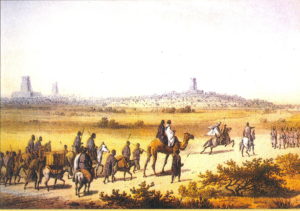 Izakhez. These nomadic people live in the deserts inland of the Agtile coast, a sandy and rocky wasteland inhabited by red-maned desert lions, hoe-tuskers, elephants, camels, and hyenas. They are a Stone Age people but make use of bronze from Zemed. They can be Trackers, Poets, and Shaman. Their Poets and Shaman make use of magical petroglyphs across the arid landscape.
Izakhez. These nomadic people live in the deserts inland of the Agtile coast, a sandy and rocky wasteland inhabited by red-maned desert lions, hoe-tuskers, elephants, camels, and hyenas. They are a Stone Age people but make use of bronze from Zemed. They can be Trackers, Poets, and Shaman. Their Poets and Shaman make use of magical petroglyphs across the arid landscape.
The Izakhez act as Traders between Zemed in the east and the Tankixa in the west, driving camel caravans across the desert. The wooded coastlines of their lands are particularly perilous, as they are inhabited by wild Ezolite giants.
Among the Izakhez, the goddess Agtil is supreme, the other Agtile gods being revered alongside the Spirit Folk in the desert. Their traditional colors are pale green and black, and they consider themselves the descendants of the lizard.
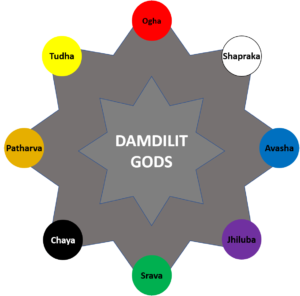 Damdilit (The High People) These Bronze Age humans have straight black hair, brown eyes, and tan skin. They live along the north shores of the Sea of Tydhem, in the lands of Nyupam, Mewas, and Addaz. They are revered as a bulwark against the wild lands under the Great Ice and for maintaining civilization on those frontiers. Their rulers are known as dhahas, and serve as the head of the Warriors and Priests of their kingdoms.
Damdilit (The High People) These Bronze Age humans have straight black hair, brown eyes, and tan skin. They live along the north shores of the Sea of Tydhem, in the lands of Nyupam, Mewas, and Addaz. They are revered as a bulwark against the wild lands under the Great Ice and for maintaining civilization on those frontiers. Their rulers are known as dhahas, and serve as the head of the Warriors and Priests of their kingdoms.
They follow a cult honoring each of the elements, and their Spirit Races, through goddesses that are paragons of the eight elements under the ancient Yuta names of the elements: Tudha of metal, Ogha of fire, Shapraka of light, Avasha of air, Jhiluba of lightning, Srava of water, Chaya of dark, and Patharva of stone. The use of Yuta names arose to overcome a communication problem with translation from Damdilit languages, which use different tones to indicate the physical, Spirit Folk, and divine meanings of the Damdilit words for the elements. The Yuta languages have no tones.
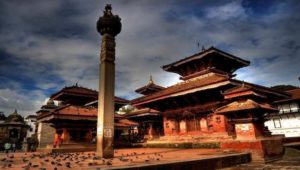 Nyupam. The Vale of Nyupam is home to the most ancient Damdilit people, the temples there among the oldest in the civilized world. The walls of these temples are decorated with the logographs of the chronicle stones, which it is said the ancient Nyupam people taught the archaic Yuta. It is from these logographs that the Yuta developed their phonetic alphabet.
Nyupam. The Vale of Nyupam is home to the most ancient Damdilit people, the temples there among the oldest in the civilized world. The walls of these temples are decorated with the logographs of the chronicle stones, which it is said the ancient Nyupam people taught the archaic Yuta. It is from these logographs that the Yuta developed their phonetic alphabet.
The dhaha of Nyupam, Hayauna, maintains close ties with the Tydhem across the seas and the Halli across the mountains. They trade in topaz and agate, and their farmers grow rice and wheat, also producing goat cheese.
The Warriors of Nyupam are renowned for their skill with the double-ended spear. Their valley is steep and its high slopes inhabited by black lions, white Peyu, and huge sheep. Their traditional colors are yellow, red, and white.
 Addaz. The land of Addaz was settled from Nyupam centuries ago, driving toward the forests of the Asnam. They grow rice and wheat on their conquered lands, which are dotted with temples to the Damdilit gods, newer but rivaling the temples of Nyupam.
Addaz. The land of Addaz was settled from Nyupam centuries ago, driving toward the forests of the Asnam. They grow rice and wheat on their conquered lands, which are dotted with temples to the Damdilit gods, newer but rivaling the temples of Nyupam.
The dhaha of Addaz, Daghitri, maintains close ties with the Tydhem across the seas, the Asnam in the high forests, and even Otovyi tribes through the pass to their wooded valley. They trade onyx and emerald, as well as ivory from the north.
Mewas. The shores of Mewas were once plagued by Zydh humanoids, until Warriors from Addaz exterminated them in a renowned war. Even now, Mewas Warriors act as mercenaries among the Addaz against the Zydh on their eastern frontier.
The dhaha of Mewas, Nogha Trisi, maintains strong ties with Izkanobil of the Bronze Crown, to maintain some independence from Addaz and Nyupam, and their Tydhem allies. His people have few resources, and primarily work as mercenaries. They fight with a distinctive Mewasi sword and short-axe combo, with a set of three javelins as a first-blood strike.
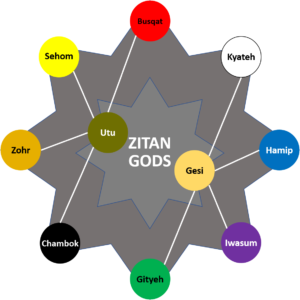 Zitan (The Cavern People) These humans have curly black hair, brown eyes, and light tan skin. They live, as their nickname suggests, in caverns in the north-west of Haya. They are Stone Age people, much like the Cro-Magnon of the real world, with no knowledge of chronicle stones or of metal except through trade with the Yuta.
Zitan (The Cavern People) These humans have curly black hair, brown eyes, and light tan skin. They live, as their nickname suggests, in caverns in the north-west of Haya. They are Stone Age people, much like the Cro-Magnon of the real world, with no knowledge of chronicle stones or of metal except through trade with the Yuta.
Zitan can be Trackers or Shaman. They are separated into two peoples, the Vyozah and the Hahmom, and these are both organized into eight totemic tribes ruled by dahzot chiefs. Each tribe has a sister-tribe in the other Zitan people. Their tribes are said to have been founded by eight totem animals that represent the elements: Chambok the Snake (dark), Zohr the Mastodon (stone), Sehom the Sabre-Tooth (metal), Busqat the Fox (fire), Kyateh the Rabbit (light), Hamip the Goose (air), Iwasum the Eagle (lightning), and Gityeh the Salmon (water).
They follow a dualist skull cult in which the cave bear god Utu and cave lion goddess Gesi represent opposing forces of strength and flexibility. Each have lesser manifestations as divine spouses. Utu and Uti embody dark, earth, metal, and fire while Gesi and Gesu embody light, air, lightning, and water. The Zitan carve and paint skulls of cave bears and cave lions to enshrine in holy caverns. Many of these are in lands now controlled by the Sihut, from whom the Zitan have negotiated pilgrimage rights.
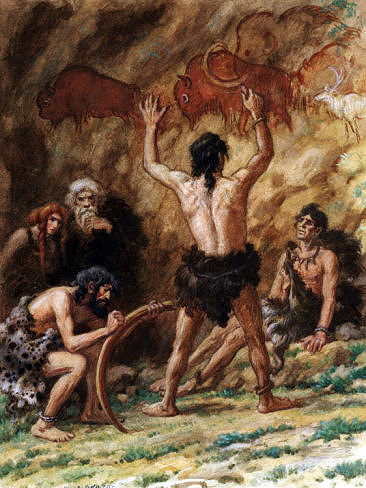 Hahmom (pronounce both H’s). These tribes live in the northern forests along the river the Sihut call Hamumia. They carry on trade between Sihut and the Himhet demihumans, primarily in furs and ivory. The also have some contact with the Asnam.
Hahmom (pronounce both H’s). These tribes live in the northern forests along the river the Sihut call Hamumia. They carry on trade between Sihut and the Himhet demihumans, primarily in furs and ivory. The also have some contact with the Asnam.
The Hahmom are a sedate people, renowned for their calm approach to danger. They have peaceful relations with their three neighbors, but have campfire tales of ancient wars with the Vyozah. Since the establishment of the Sihut on the southern shores of Zitan, the Hahmom tribes have established pilgrimage, trading, and inter-marriage relationships with their sister-tribes among the Vyozah, with whom they no longer share a contested border.
Although they do not have a Poet (bard) class, the Shaman of Hahmom are renowned for their flutes, which they prefer to fashion from the bones of wolves (due to their howling) and the branches of spruce.
Vyozah (pronounce the final H). These tribes live in the forests of the mountain-ringed river the Sihut call Viyusa. They carry on trade in furs and mastodon tusks with Sihut, but are bellicose toward the Atzot, whose weaker coastal settlements they regularly raid.
They are a fierce people, renowned for their brutality in combat. They now have peaceful relations with the Hahmom, but used to raid their lands before the establishment of the Sihut along the southern coast of Zitan.
Although they do not have a Poet (bard) class, the Shaman of Vyozah are renowned for their drums, which they prefer to fashion from the hides of musk oxen and the wood of the oak.
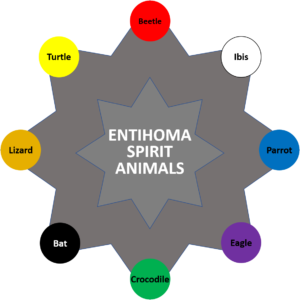 Entihoma (The East People) These humans have wavy to curly black hair, brown eyes, and dark skin. They live in the far south-east of Haya, beyond the dust wastes of the Janis demihumans, in Avada and the island of Vava. They are a Stone Age people, with no knowledge of chronicle stones or of metal except through trade with the Adya.
Entihoma (The East People) These humans have wavy to curly black hair, brown eyes, and dark skin. They live in the far south-east of Haya, beyond the dust wastes of the Janis demihumans, in Avada and the island of Vava. They are a Stone Age people, with no knowledge of chronicle stones or of metal except through trade with the Adya.
Entihoma can be Trackers or Shaman. Their Shaman maintain oral chronicles that they refuse to allow outsiders to translate to chronicle stones. The Entihoma have no formal leadership, each tribe generally following the guidance of their Shaman and chief Warriors.
They follow a cult of connection with the Spirit Folk of the eight elements. They have no knowledge of gods except as elemental animal paragons of the Spirit Races: the Beetle (fire), the White Ibis (light), the Blue Parrot (sky), the Eagle (lightning), the Giant Crocodile (water), the Bat (dark), the Lizard (stone), and the Turtle (metal). The Avada also recognize the flightless, predatory bird ru’e as a powerful spirit of war and death, and the Vava honor the pig as a spirit of knowledge and fertility. Also honored by both Entihoma peoples is the octopus as a spirit of mischief and wisdom.
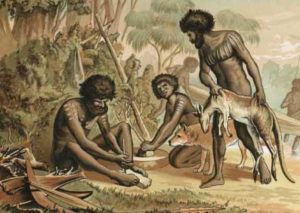 Avada. The people who dwell on the far eastern corner of the same continent as the Agtile and Janis, the Avada survive in a dry land haunted by eight-foot-tall, flightless, predatory birds they call ru’e. They hunt jangi (kangaroo) but also make use of a strikingly broad array of animal and plant foodstuffs in their desert homeland.
Avada. The people who dwell on the far eastern corner of the same continent as the Agtile and Janis, the Avada survive in a dry land haunted by eight-foot-tall, flightless, predatory birds they call ru’e. They hunt jangi (kangaroo) but also make use of a strikingly broad array of animal and plant foodstuffs in their desert homeland.
The Avada are the most isolated of the True People, having only occasional contact with the Vava, Wesadhi, and Zemed.
The Avada enjoy the free skill of Survival at +2 in any environment; due to the harshness of their own environment, they have focused their Wisdom on the needs and opportunities of any current situation.
Vava. These people live on a mountainous, heavily forest island and survive both by hunting pigs and making use of all of the plant and animal resources of their lands. They occasionally trade with the Adya and Wesadhi for spices and rare fruits.
The Vava can be Trackers or Shaman. The Vava enjoy the free skill of Survival at +2 in any environment; due to the harshness of their own environment, they have focused their Wisdom on the needs and opportunities of any current situation.
Outer People (Demihumans and Quasihumans)
The demihuman and quasihuman races, analogous to prehistoric forms of the genus Homo in the real world, live on the peripheries of civilization. They are all Stone Age peoples, without knowledge of chronicle stones or metal tools.
In general, the Outer People should be confined to non-player characters. But, individual gaming groups can open them up to players.
Asnam (The Gold Hairs). These quasihuman people live in the forests and nearby meadows between the Damdilit and the Great Ice. There is a philosophical debate among the True People whether the Gold Hairs of the middle north are indeed True People. In face and stature, they appear much as the True People, but they have blonde wavy hair, blue eyes, and cream-colored skin. They tend to be a bit taller than humans. They use bows and arrows to hunt, and are very dexterous and nimble. They enjoy a bonus of +2 to dexterity and wisdom, and a penalty of -2 to strength.
The Asnam have access to the Tracker and Elder classes. Their Elders (druids) make use of magical symbols carved into stones and trees. They follow a cult of the goddess Zoyet—represented by the elements of metal, earth, dark, and water—and the god Gayet—represented by the elements of fire, light, air, and lightning. Their Elders also have close relations to the Spirit Folk. Their lands are filled with mastodons, cave bears, vadin (reindeer), dire wolves, and giant boars.
Asnam enjoy magic resistance that makes them immune to spells of 3rd level and below. They are a very conscientious and serene people, revered among the humans as remaining close to nature without being brutish, primitive folk like the demihumans. They dress in multi-colored clothing that differs from clan to clan, but usually include white, red, and black.
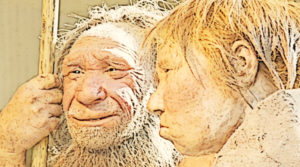 Himhet (The Red Hairs). Similar to the Neanderthals of the real world, the Himhet are short, stocky demihumans with red curly hair, green eyes, and pinkish skin, Stone Age hunter-gatherers who hunt with thrusting spears against prey like mammoth and woolly rhino on the plains, mastodon in the woodlands, and musk ox. Therefore, they are very tough and brutal. They enjoy a bonus of +3 to strength, and a penalty of -1 to dexterity, constitution, and intelligence.
Himhet (The Red Hairs). Similar to the Neanderthals of the real world, the Himhet are short, stocky demihumans with red curly hair, green eyes, and pinkish skin, Stone Age hunter-gatherers who hunt with thrusting spears against prey like mammoth and woolly rhino on the plains, mastodon in the woodlands, and musk ox. Therefore, they are very tough and brutal. They enjoy a bonus of +3 to strength, and a penalty of -1 to dexterity, constitution, and intelligence.
The Himhet have access to the Hunter (barbarian) and Shaman (sorceror) classes.
They follow a cult wherein each element, and each Spirit Race, are represented by animals. Fire is the woolly rhino, light is the snow owl, air is the eagle, lightning is the dire wolf, water is the salmon, dark is the cave bear, stone is the woolly mammoth, and metal is the great elk.
Janis (The Dust People) Similar to the Homo ergaster of the real world, the Janis are short, hardy demihumans with dark curly hair, amber eyes, and dark skin. They live in the deserts and scrublands of the middle south, using thrown spears to hunt.
The Janis have access to the Tracker and Shaman classes. They follow a cult of two opposing spirits, the dragon of death (the monitor lizard) and the tree of life. They also have close ties to the Spirit Folk of their realms.
They enjoy +2 to Dexterity and Wisdom, and -2 to Charisma due to their cheerful way of facing hardship. Many never live to see this cheerfulness, however, since they are fiercely territorial and mistrustful of outsiders.
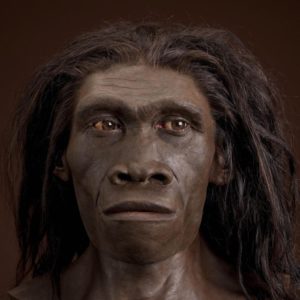 Otovyi (The Wood People) Similar to the Homo erectus of the real world, the Otovyi are short, wiry demihumans with dark wavy hair, gray eyes, and dark skin. They live in a wooded valley in the north-east of Haya, using thrown spears to hunt mastodons, Sky-Beasts, and the smaller creatures of the forests.
Otovyi (The Wood People) Similar to the Homo erectus of the real world, the Otovyi are short, wiry demihumans with dark wavy hair, gray eyes, and dark skin. They live in a wooded valley in the north-east of Haya, using thrown spears to hunt mastodons, Sky-Beasts, and the smaller creatures of the forests.
The Otovyi have access to the Tracker and Elder classes. They follow a cult of the Sabre-Tooth Cat and maintain close ties to the Spirit Folk of their forests.
The Otovyi enjoy a +2 to strength and dexterity, and -2 to intelligence and wisdom.
Razu (The Old People) A short Stone Age humanoid with dark, curly hair and yellowish skin, they stand no more than four feet tall. They once ranged throughout the lands now dominated by Yuta humans, and they have a close relationship to water, loving to swim and catch fish, although they are now confined to upland areas where the only water is freshwater.
They enjoy a bonus of +3 to dexterity and wisdom, and a penalty of -3 to strength. They can be Trackers (rangers) and have a close relationship to the Spirit Folk.
Sebilos (The Stone Hairs) In face and stature, they are much like the Himhet. They have brown wavy hair, hazel eyes, and tan skin. They use spear-throwers to hunt, and have great aim and wisdom.
The Sebilos have access to the tracker and shaman classes. They follow a cult of a woolly mammoth Mother Goddess and a woolly rhino Father God.
Tsote (The Flower People) A short Stone Age humanoid with curly hair having stripes of blond, brown, and red, they stand no more than four feet tall.
They once lived throughout the islands now dominated by Adya humans, among whom they are known as the Flower People for their multicolored hair. They now live only in the forested uplands of Wesadhi among the Kaba quasihumans and Metamhi humanoids, having close relations with the Spirit Folk.
They can be Trackers (rangers), enjoy a bonus of +3 to dexterity and wisdom, and a penalty of -3 to strength.
Under People (humanoids) These are the primary monster NPC races. Individual gaming groups might be tempted to include some of them as PC races. They are considered distant in heritage by human True People.
 Ezolites. A giant, Neanderthal-like race standing up to ten feet tall, with white skin, dark red hair, and green eyes. They enjoy a bonus to strength and constitution of +3, and a penalty of -3 to intelligence and wisdom.
Ezolites. A giant, Neanderthal-like race standing up to ten feet tall, with white skin, dark red hair, and green eyes. They enjoy a bonus to strength and constitution of +3, and a penalty of -3 to intelligence and wisdom.
Most Ezolites live as Stone Age Trackers (rangers) along the coast of the southern continent, but some have become domesticated by the Zemed as mercenary Warriors (fighters). Ezolites are calm but brutal creatures, capable of severe violence.
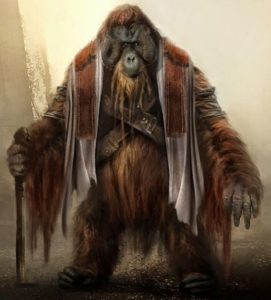 Metamhi. An ape-like humanoid, much like an evolved form of orangutan, who live in the forests of the Adya realm. They are experts at travelling among the limbs of trees. They live in Stone Age tribes, communing with Spirit Folk. They enjoy a bonus to strength, dexterity, and constitution of +3, and a penalty of -3 to intelligence and wisdom.
Metamhi. An ape-like humanoid, much like an evolved form of orangutan, who live in the forests of the Adya realm. They are experts at travelling among the limbs of trees. They live in Stone Age tribes, communing with Spirit Folk. They enjoy a bonus to strength, dexterity, and constitution of +3, and a penalty of -3 to intelligence and wisdom.
Metamhi have reddish fur, brown eyes, and are about four feet tall. They can be Trackers (rangers). Metamhi are reclusive and avoid conflict, preferring to call upon their Spirit Folk allies for defense.
Ohti. A huge humanoid, much like a giant Homo erectus, who live in remote gorges in the northern steppes under the Great Ice. They have evolved pale skin, icy gray eyes, and white hair.
Ohti hunt mammoths, woolly rhinos, and musk oxen with stone axes. They stand about twelve feet tall. They enjoy a bonus to strength and constitution of +3, and a penalty of -3 to intelligence and wisdom. They can be Hunters (barbarians), and are known to be violent and reclusive.
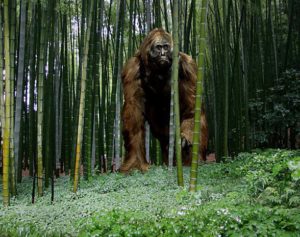 Peyu. An ape-like humanoid, much like the Gigantopithecus of our real world, who live in the mountains and high forests above where Yuta, Damdilit, and Adya humans dwell. They have gray eyes and stand 12 to 20 feet tall. Other than the details here (and in the monsters section) the stats for peyu are as Megaprimatus in d20.
Peyu. An ape-like humanoid, much like the Gigantopithecus of our real world, who live in the mountains and high forests above where Yuta, Damdilit, and Adya humans dwell. They have gray eyes and stand 12 to 20 feet tall. Other than the details here (and in the monsters section) the stats for peyu are as Megaprimatus in d20.
White-furred Peyu live in the icy mountains of Halbhar, black-furred Peyu in the rugged Peyu mountains to the east of Addaz, and red-furred Peyu in the high bamboo valley of Zengulay above Zasai.
Peyu are herbivores who occasionally scavenge dead sheep, goat, and musk oxen. They have primitive Stone Age technology, and can be Trackers (rangers). They enjoy a bonus of +3 to strength and constitution, and a penalty of -3 to intelligence and wisdom. Peyu are reclusive, but also very peaceful and compassionate to other creatures, although they can be quite violent when confronted.
Zhyndh. A fanged, bulky, copper-skinned, black-haired humanoid—like a regressive form of Neanderthal—live along rocky coasts in the lands now dominated by Yuta humans, among whom they are known as the Toothed People.
The Razu have ancient tales of conflict with the Zhyndh, and these fierce humanoids continue to plague the borders of human lands. They stand five to six feet tall, enjoy a bonus of +3 to strength and constitution, with a penalty of -3 to intelligence and wisdom. They can be Hunters (barbarians) and Shaman (sorcerors) and maintain a close relationship with Spirit Folk who are hostile to humanity.
